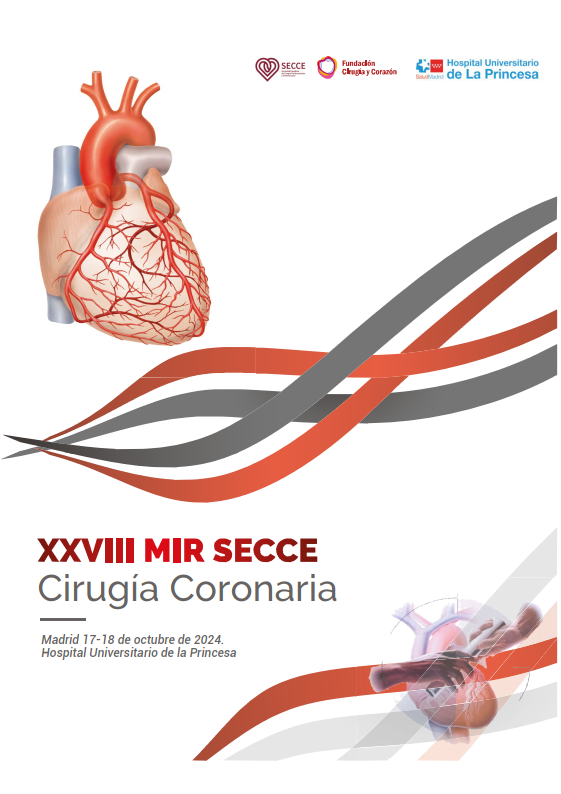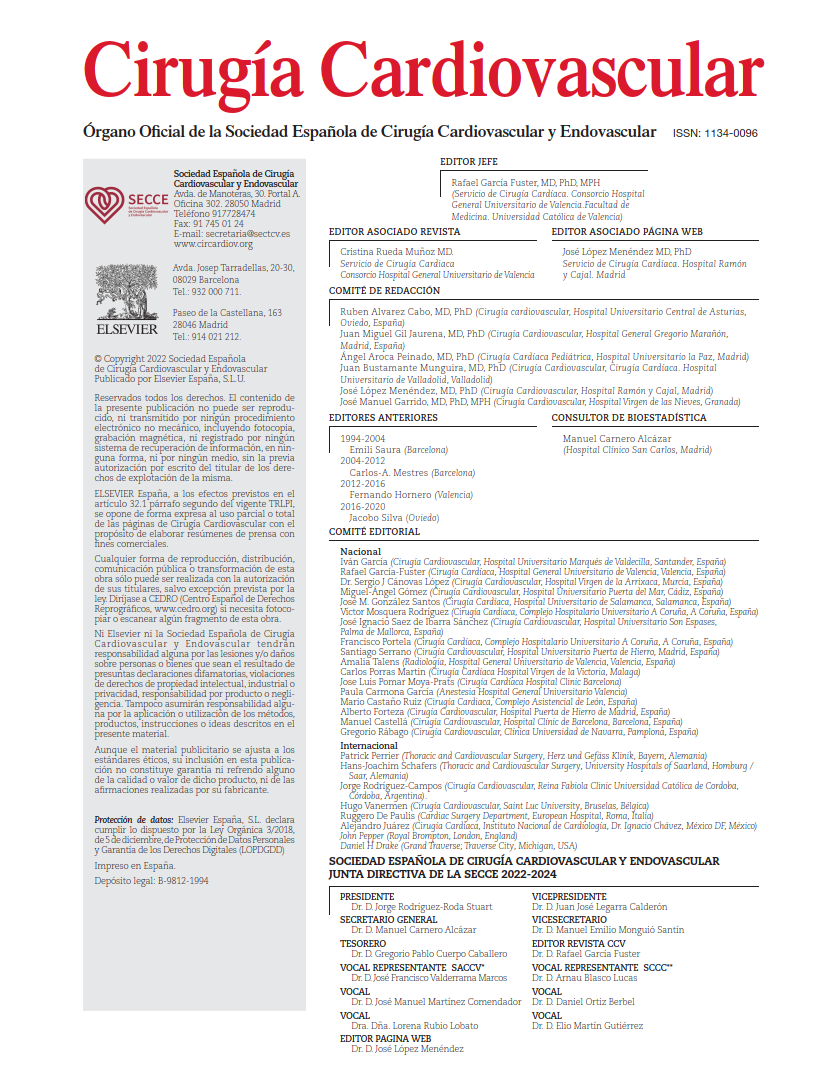Presented during the 2025 ESC Congress in Madrid, these guidelines represent a significant shift from the 2021 edition. They embrace a more proactive and less invasive clinical attitude, driven by accumulating evidence from randomized trials and real-world registries. The document also strengthens the function of Heart Valve Teams and Heart Valve Networks, supports a more personalized approach to care, and establishes computed tomography as the first-line test to rule out coronary artery disease before valvular intervention.
Beyond a more patient-centered tone, the guidelines introduce concrete modifications that directly impact surgical practice and shared decision-making between cardiologists and surgeons. The following summary highlights the most relevant updates from a surgical perspective, without attempting to exhaust all nuances or evidence. The final commentary offers a personal critical reflection on the aspects with the greatest implications for daily clinical practice.
- Aortic valve
1.1 Aortic stenosis
The most significant change concerns the timing of intervention. The guidelines now consider treatment in asymptomatic patients with severe high-gradient aortic stenosis and preserved ventricular function when procedural risk is low and there is evidence of rapid progression, myocardial fibrosis, or elevated biomarkers (NT-proBNP or troponin). This approach partially abandons the former “watchful waiting” strategy and reflects evidence of a prognostic benefit with early intervention.
The age threshold for TAVI decreases from 75 to 70 years in patients with tricuspid aortic valves and suitable anatomy. Transcatheter treatment is recommended from that age onward, while surgical aortic valve replacement remains the standard in younger patients with favorable anatomy and long life expectancy. The role of non-transfemoral TAVI is also updated, being accepted as a valid option for patients unsuitable for either surgery or femoral access.
The text emphasizes individualized decision-making based on anatomy, expected prosthesis durability, and lifetime management strategy. However, this concept becomes less clear with the introduction of a stricter and earlier age cut-off.
1.2 Aortic regurgitation
A major novelty is the possibility of considering TAVI in symptomatic inoperable patients with suitable anatomy, an option absent from previous editions.
Surgical criteria in asymptomatic patients have been refined, establishing new thresholds for ventricular size and function (LVESDi >22 mm/m², LVESVi >45 mL/m², or LVEF ≤55%) as indications for surgery in experienced centers and low-risk patients. These parameters aim to identify subclinical ventricular dysfunction before overt decline in ejection fraction.
Finally, the guidelines strongly encourage aortic valve repair in expert centers when durable outcomes are expected, reinforcing its role over replacement in young patients and those with bicuspid valves.
- Mitral valve
2.1 Primary (degenerative) mitral regurgitation
The new guidelines reinforce surgical repair as the treatment of choice for most patients with severe primary mitral regurgitation and repairable anatomy, preferably in high-volume reference centers.
However, the most relevant update concerns earlier surgical indication. Surgery is now recommended in asymptomatic, low-risk patients when at least three additional factors are present—such as atrial fibrillation, pulmonary hypertension, significant left atrial enlargement, or concomitant tricuspid regurgitation. This change reflects a more proactive approach aimed at preventing irreversible atrial and ventricular remodeling.
The document also highlights the value of minimally invasive surgery in expert centers, noting its potential to shorten recovery time and improve quality of life without compromising long-term durability outcomes.
In parallel, transcatheter therapies continue to expand. TEER (transcatheter edge-to-edge repair)—using either Abbott MitraClip® or Edwards PASCAL®—is now considered a Class IIa recommendation for symptomatic high-risk surgical patients with favorable anatomy, provided that the expected outcome is comparable to surgery.
2.2 Secondary (functional) mitral regurgitation
In this field, the guidelines formally distinguish between two phenotypes: ventricular secondary MR and atrial secondary MR, each with specific therapeutic implications.
For ventricular SMR, the most relevant update is the elevation of TEER to a Class I, Level A recommendation in symptomatic patients with LVEF <50%, persistent severe regurgitation, and favorable anatomy despite optimized medical therapy and resynchronization. This establishes TEER as the reference treatment for an increasingly broad population, although current evidence mainly derives from COAPT-type cohorts (proportionate regurgitation, non-dilated ventricles, and optimal medical management).
In atrial SMR, surgery combined with atrial fibrillation ablation and left atrial appendage closure is recommended when anatomy and ventricular function are suitable, while TEER is reserved for patients who remain symptomatic and are unsuitable for surgery after optimization of medical and rhythm-control therapy.
The guidelines stress that careful patient selection remains crucial, underscoring the need for comprehensive multimodality imaging and discussion within the Heart Team.
2.3 Mitral stenosis
Although the changes are minor, the approach to calcific degenerative mitral stenosis has been updated. For the first time, transcatheter mitral valve replacement (TMVI) is introduced as an option for high-risk surgical patients with a calcified mitral annulus (valve-in-MAC), but only in experienced centers.
Balloon percutaneous valvuloplasty remains the first-line treatment for rheumatic disease when anatomy is favorable, whereas surgery continues to be indicated in cases with advanced calcification, atrial thrombus, and/or significant associated mitral regurgitation.
- Tricuspid and pulmonary valve
3.1 Tricuspid valve
The 2025 guidelines grant the tricuspid valve an unprecedented level of attention. For the first time, they recommend systematic, multidisciplinary evaluation by the Heart Team before any intervention, reflecting growing recognition of the prognostic impact of significant tricuspid regurgitation.
They strengthen the indication for concomitant surgical repair during left-sided valve surgery, assigning a Class Irecommendation for severe tricuspid regurgitation and suggesting that it should be considered in cases of moderate regurgitation with annular dilation (≥40 mm or >21 mm/m²). This update aims to prevent disease progression and reduce the need for late reoperations.
The major novelty is the formal inclusion of transcatheter tricuspid valve intervention (TTVI), which receives a Class IIa, Level A recommendation in symptomatic high-risk surgical patients with suitable anatomy, provided there is no severe right ventricular dysfunction or precapillary pulmonary hypertension. The update draws on studies using devices such as Abbott TriClip®, Edwards EVOQUE®, and Cardioband®, which have shown improvements in functional class and quality of life, although follow-up remains limited. So far, neither TRILUMINATE Pivotal nor EVOQUE Pivotal have demonstrated a mortality reduction, but both showed consistent symptomatic and functional improvement.
The document also highlights the importance of comprehensive anatomic assessment using multimodality imaging (3D echocardiography, CT, MRI) to guide device selection and procedural planning. Altogether, the guidelines consolidate an integrated approach to tricuspid regurgitation, even though long-term evidence remains limited and current clinical enthusiasm may still outpace the robustness of the data.
3.2 Pulmonary valve
Recommendations regarding the pulmonary valve have changed little, though the possibilities for transcatheter therapy continue to expand. Transcatheter pulmonary valve replacement (TPVR) retains a Class I recommendation in patients with significant dysfunction of conduits or previous bioprostheses, with well-established long-term outcomes.
Technological advances have broadened the anatomic applicability of TPVR, extending its indications to more complex anatomies. Nevertheless, the guidelines stress the need for careful patient selection and meticulous procedural planning with multimodality imaging, particularly in the setting of congenital heart disease or nonstandard anatomy. In such cases, reference is made to the dedicated congenital heart disease guidelines, emphasizing the importance of evaluation in specialized centers with expertise in right-sided structural interventions.
COMMENTARY:
The 2025 ESC/EACTS Guidelines deserve credit for taking a decisive step toward a more proactive, evidence-driven clinical approach—but that leap is not without risks. From a surgical standpoint, several critical issues deserve careful consideration:
Durability and long-term uncertainty of TAVI in younger patients.
Lowering the age threshold to 70 years as the preferred cut-off for TAVI seems somewhat premature, given the limited long-term data available. The only randomized trial with 10-year follow-up, NOTION, showed equivalent all-cause mortality between TAVI and surgery, with no significant difference in clinically relevant structural valve deterioration. However, the study population was elderly (mean age around 79 years), involved first-generation devices, and included a small number of events.
In PARTNER 3, 5-year results reveal mortality curves that tend to cross in favor of surgery around years 2–3, though without statistical significance. Solid durability data beyond this timeframe are still lacking.
Moreover, it is striking that the new guidelines have not given any weight to studies such as the meta-analysis of randomized trials published by Doenst et al., which shows that, at five years, the only significant differences between surgery and TAVI are a higher incidence of paravalvular leakage and permanent pacemaker implantation in the transcatheter group.
Applying a rigid age threshold of 70 years overlooks the structural uncertainty beyond 5–8 years and the higher likelihood of reintervention in patients with long life expectancy. Furthermore, contemporary registry data have shown—and this blog has previously discussed—that surgical reinterventions after TAVI explantation carry a markedly higher mortality (15–25%) than conventional prosthetic reoperations. Added to that are concerns related to future coronary access, paravalvular leakage, and a higher incidence of conduction disorders requiring pacemaker implantation.
Early intervention in asymptomatic aortic stenosis: risk of overdiagnosis and overtreatment.
The new option to intervene in asymptomatic patients with rapid gradient progression or heavy calcific burden, even without ventricular dysfunction, is conceptually appealing but not yet strongly supported by robust trial evidence demonstrating a net survival or quality-of-life benefit. Earlier surgery may expose patients to procedural risks without proven long-term gain. More objective, multimodal criteria integrating imaging, biomarkers, and individualized risk assessment are still needed.
Expanded TEER indications in primary and secondary MR: balancing early safety and long-term durability.
Assigning a Class IIa recommendation to TEER even in intermediate-risk patients with degenerative MR may be premature. Comparative data versus surgical repair remain limited, with relatively short follow-up. High-quality surgical repair continues to provide unmatched durability, while TEER offers lower upfront risk but inferior midterm structural outcomes.
In ventricular secondary MR, upgrading TEER to Class I, Level A could inadvertently extend its use beyond COAPT-like populations, ignoring that MITRA-FR produced neutral results. Strict patient selection remains paramount.
Hybrid procedures for calcified mitral annulus: a notable omission.
It is striking that the guidelines make no mention of hybrid surgical–transcatheter strategies for mitral annular calcification, despite encouraging results from multiple recent series. In experienced centers, surgical implantation of transcatheter valves under direct vision with cardiopulmonary bypass has shown a progressive decline in mortality in recent years. This evolving and reproducible approach offers a real alternative for high-risk patients, while fully percutaneous valve-in-MAC procedures remain associated with substantial early mortality and risk of left ventricular outflow tract obstruction.
Transcatheter therapies for tricuspid valve disease: yet no proven survival benefit.
The 2025 update introduces a Class IIa recommendation for TTVI (including devices such as TriClip®, Cardioband, EVOQUE®, and heterotopic valves). Although promising, none of the pivotal trials (TRILUMINATE Pivotal, EVOQUE Pivotal) have demonstrated a reduction in mortality or major adverse events. Symptomatic and quality-of-life improvements are clear, but long-term outcome data remain pending. Thus, enthusiasm should be tempered until stronger evidence emerges.
CT-first strategy for coronary evaluation: sound principle, but not universally applicable.
Introducing computed tomography as the initial step to exclude coronary artery disease may streamline workflow, yet it cannot replace invasive angiography in patients with high pre-test probability, heavy calcification, or risk of missing relevant stenoses. A rigid CT-first algorithm could lead to errors if not adapted to clinical context.
The paradox of “lifetime management” under rigid rules.
While the guidelines promote lifetime management of valvular disease, they simultaneously impose fixed thresholds (age 70 years, expanded transcatheter indications) that may constrain nuanced decision-making. In practice, rigid algorithms risk overshadowing clinical judgment and anatomical–physiological reasoning, which remain the foundation of individualized care.
The 2025 guidelines should indeed guide, not dictate. Integrating new evidence and therapeutic advances is essential, but surgical judgment—rooted in anatomy, durability, center experience, and long-term balance of risk and benefit—must remain the cornerstone of decision-making.
REFERENCE:
Praz F, Borger MA, Lanz J, Marin-Cuartas M, Abreu A, Adamo M, et al.; ESC/EACTS Scientific Document Group. 2025 ESC/EACTS Guidelines for the management of valvular heart disease. Eur J Cardiothorac Surg. 2025 Aug 2;67(8):ezaf276. doi: 10.1093/ejcts/ezaf276.



